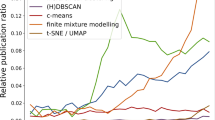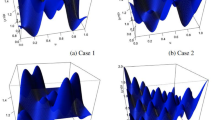Abstract
Mixture models have received a great deal of attention in statistics due to the wide range of applications found in recent years. This paper discusses a finite mixture model of Birnbaum–Saunders distributions with G components, which is an important supplement to that developed by Balakrishnan et al. (J Stat Plann Infer 141:2175–2190, 2011) who considered a model with two components. Our proposal enables the modeling of proper multimodal scenarios with greater flexibility for a model with two or more components, where a partitional clustering method, named k-bumps, is used as an initialization strategy in the proposed EM algorithm to the maximum likelihood estimates of the mixture parameters. Moreover, the empirical information matrix is derived analytically to account for standard error, and bootstrap procedures for testing hypotheses about the number of components in the mixture are implemented. Finally, we perform simulation studies to evaluate the results and analyze two real dataset to illustrate the usefulness of the proposed method.







Similar content being viewed by others
Notes
R codes can be obtained from the contact author upon request.
References
Bagnato L, Punzo A (2013) Finite mixtures of unimodal beta and gamma densities and the \(k\)-bumps algorithm. Computat Stat 28:1571–1597
Balakrishnan N, Leiva V, Sanhueza A, Cabrera E (2009) Mixture inverse gaussian distributions and its transformations, moments and applications. Statistics 43(1):91–104
Balakrishnan N, Gupta R, Kundu D, Leiva V, Sanhueza A (2011) On some mixture models based on the Birnbaum-Saunders distribution and associated inference. J Stat Plann Infer 141:2175–2190
Basso RM, Lachos VH, Cabral CRB, Ghosh P (2010) Robust mixture modeling based on scale mixtures of skew-normal distributions. Comput Stat Data Anal 54:2926–2941
Bechtel Y, Bonaiti-Pellie C, Poisson N, Magnette J, Bechtel P (1993) A population and family study of n-acetyltransferase using caffeine urinary metabolites. Clin Pharmacol Therapeut 54:134–141
Birnbaum Z, Saunders S (1969) A new family of life distributions. J Appl Probab 6:319–327
Chandra S (1977) On the mixtures of probability distributions. Scandin J Stat 4:105–112
Chang W, Cheng J, Allaire J, Xie Y, McPherson J (2017) Shiny: web Application Framework for R. R package version 1:3
Dempster AP, Laird NM, Rubin DB (1977) Maximum likelihood from incomplete data via the EM algorithm. J Royal Stat Soci, Series B 39:1–38
Efron B, Tibshirani R (1986) Bootstrap methods for standard errors, confidence intervals, and other measures of statistical accuracy. Stat Sci 1(1):54–75
Kaufman L, Rousseeuw P (1990) Finding groups in data. Wiley, New York
Khosravi M, Kundu D, Jamalizadeh A (2014) On bivariate and mixture of bivariate Birnbaum-Saunders distributions. Stat Methodol 23:1–17
Leiva V (2016) The Birnbaum-Saunders distribution. Elsevier, Amsterdam
Leiva V, Tejo M, Guiraud P, Schmachtenberg O, Orio P, Marmolejo-Ramos F (2015) Modeling neural activity with cumulative damage distributions. Biol Cybernet 109(4):421–433
Louis T (1982) Finding the observed information matrix when using the EM algorithm. J Royal Stat Soci, Series B 44:226–233
Maehara R, Benites L (2015) bssn: Birnbaum-Saunders model based on skew-normal distribution. R package version 0.6
McLachlan GJ, Peel D (2000) Finite mixture models. Wiley, New York
Meng X (1994) On the global and componentwise rates of convergence of the EM algorithm. Linear Algebr Appl 199:413–425
Meng X, Rubin DB (1993) Maximum likelihood estimation via the ECM algorithm: a general framework. Biometrika 81:633–648
Mengersen K, Robert CP, Titterington DM (2011) Mixtures: estimation and applications. Wiley, New york
Mouselimis L, Sanderson C, Curtin R, Agrawal S, Frey B, Dueck D (2016) ClusterR: Gaussian mixture models, k-means, mini-batch-kmeans, k-medoids and affinity propagation clustering. R package version 1:1
Ng H, Kundu D, Balakrishnan N (2003) Modified moment estimation for the two-parameter Birnbaum-Saunders distribution. Comput Stat Data Analys 43:283–298
Olmos N, Martínez-Flórez G, Bolfarine H (2016) Bimodal Birnbaum-Saunders distribution with applications to non-negative measurements. Communicat Statistics-Theory Methods 46(13):6240–6257
Prates M, Lachos V, Cabral C (2013) mixsmsn: Fitting finite mixture of scale mixture of skew-normal distributions. R package version 1:1
R Core Team (2016) R: A language and environment for statistical computing. R Foundation for Statistical Computing, Vienna, Austria
Rieck J (1989) Statistical analysis for the birnbaum-saunders fatigue life distribution. Ph.d.dissertation, Clemson University
Rieck J (1999) A moment-generating function with application to the Birnbaum-Saunders distribution. Communicat Statistics - Theory Meth 28(9):2213–2222
Schwarz G (1978) Estimating the dimension of a model. Annals Stat 6:461–464
Stasinopoulos MD, Rigby RA, Bastiani FD (2018) Gamlss: A distributional regression approach. Stat Modell 18(3–4):248–273
Teicher H (1967) Identifiability of product measures. Annal Math Stat 38:1300–1302
Turner TR (2000) Estimating the propagation rate of a viral infection of potato plants via mixtures of regressions. J Royal Stat Soci: Series C (Appl Stat) 49(3):371–384
Wang M, Zhao J, Sun X, Park C (2013) Robust explicit estimation of the two-parameter Birnbaum-Saunders distribution. J Appl Stat 40(10):2259–2274
Yakowitz S, Spragins J (1968) On the identifiability of finite mixtures. Annal Math Stat 39:209–214
Acknowledgements
Note that a pre-print version of this manuscript can be found at https://arxiv.org/abs/1708.00476. The current published article is thus an improved and updated version of that work and should become the key reference relating to that work. The computer program, coded in the R language, is available from the first author upon request. We also thank Alejandro Aybar Flores from Universidad del Pacífico for his help in the Shiny app. The authors thank Joan Gladwyn (https://properwords.co.nz/) for proofreading this manuscript.
Author information
Authors and Affiliations
Corresponding author
Ethics declarations
Conflict of interest
The authors declare that they have no conflict of interest.
Additional information
Publisher's Note
Springer Nature remains neutral with regard to jurisdictional claims in published maps and institutional affiliations.
Supplementary Information
Below is the link to the electronic supplementary material.
Rights and permissions
About this article
Cite this article
Benites, L., Maehara, R., Vilca, F. et al. Finite Mixture of Birnbaum–Saunders Distributions Using the k-Bumps Algorithm. J Stat Theory Pract 16, 17 (2022). https://doi.org/10.1007/s42519-022-00245-z
Accepted:
Published:
DOI: https://doi.org/10.1007/s42519-022-00245-z




